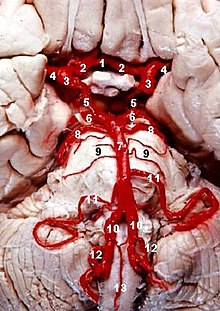|
Medial pontine syndrome
Medial inferior pontine syndrome is a condition associated with a contralateral hemiplegia.[citation needed]"Medial inferior pontine syndrome" has been described as equivalent to Foville's syndrome.[1] PresentationAlthough medial pontine syndrome has many similarities to medial medullary syndrome, because it is located higher up the brainstem in the pons, it affects a different set of cranial nuclei.[citation needed]
Depending upon the size of the infarct, it can also involve the facial nerve. Cause Medial pontine syndrome results from occlusion of paramedian branches of the basilar artery.[citation needed]
Treatment
See also
References
External links
|
||||||||||||||||||
